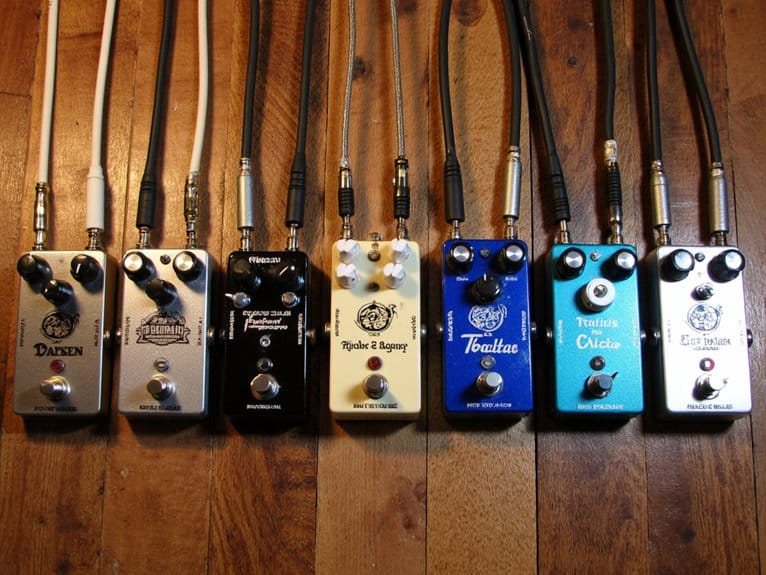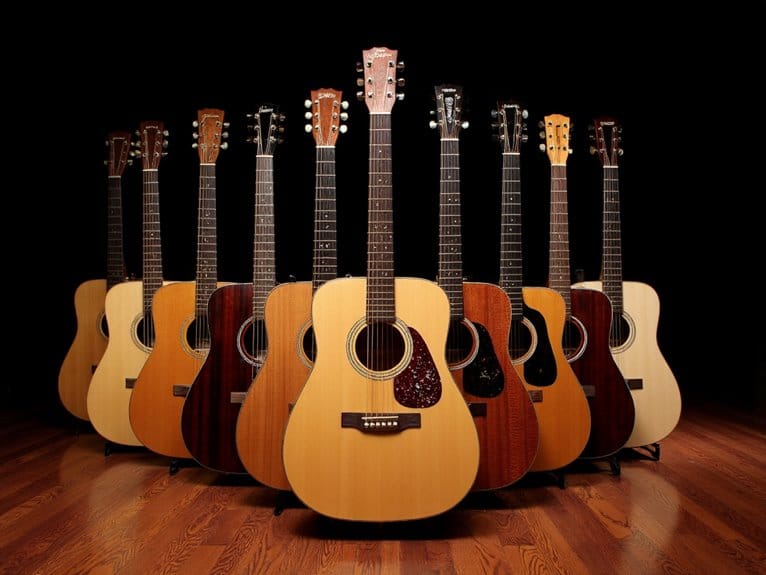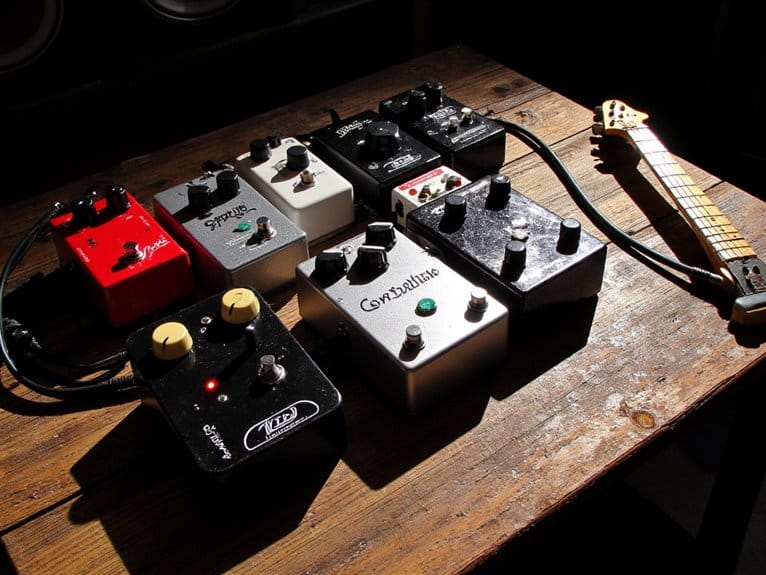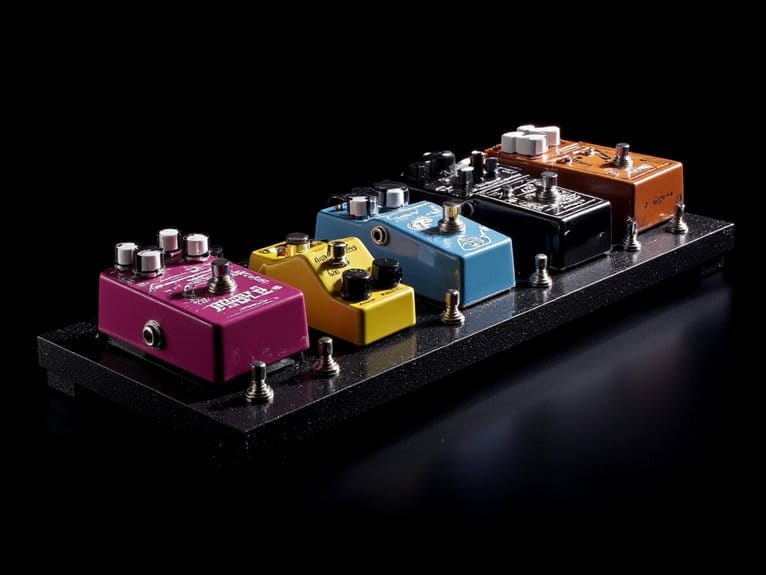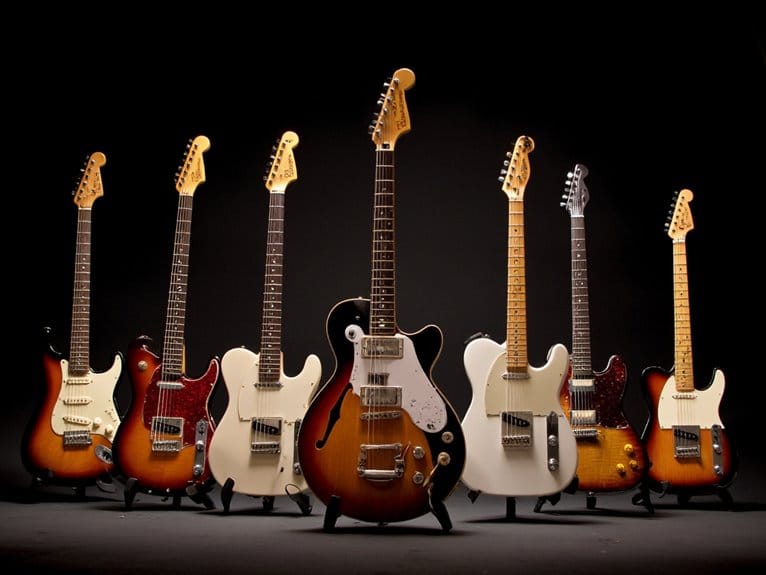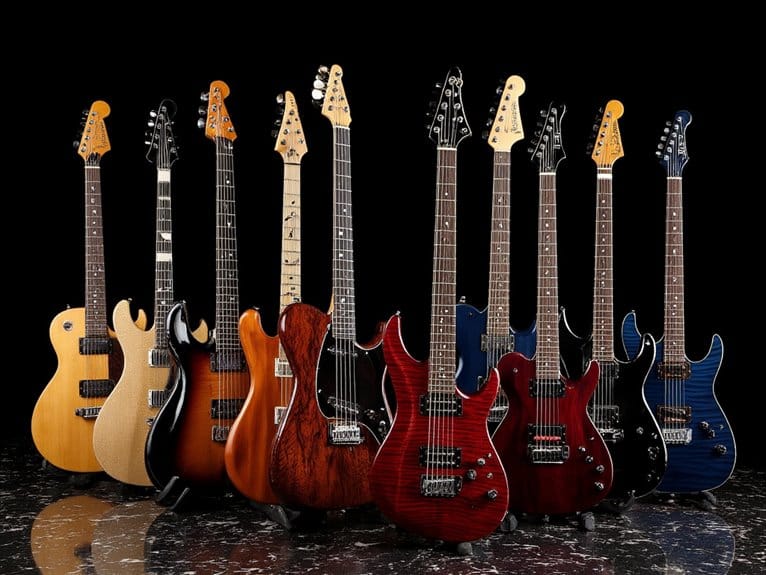10 Best Distortion Guitar Pedals That Will Transform Your Sound
I’ve tested countless distortion pedals, and the best ones transform your guitar’s voice completely, delivering everything from warm tube-amp breakup to crushing high-gain saturation. Top performers include the JOYO High Gain Distortion (JF-04), FLAMMA FC06 with HP/LP modes, and Donner Morpher Mini featuring three distinct distortion modes. These pedals offer true bypass switching, durable aluminum construction, and versatile controls that maintain note clarity across genres. Below, I’ll break down each pedal’s unique strengths and help you find your perfect tone companion.
We are supported by our audience. When you purchase through links on our site, we may earn an affiliate commission, at no extra cost for you. Learn more.
Notable Insights
- High-gain distortion pedals deliver authentic tube-amp breakup and vintage amplifier tone without digital artifacts or bulk.
- True bypass switching and aluminum-alloy construction ensure signal integrity and durability for live performances and studio use.
- Popular models like JOYO High Gain and Donner Distortion average 4.3 stars with versatile tone controls.
- Price ranges from $50-$200+ with budget options for beginners and premium models offering advanced features.
- Wide adjustment ranges allow customization from clean boost to high-gain saturation across multiple genres.
High Gain Distortion Pedal for Electric Guitar
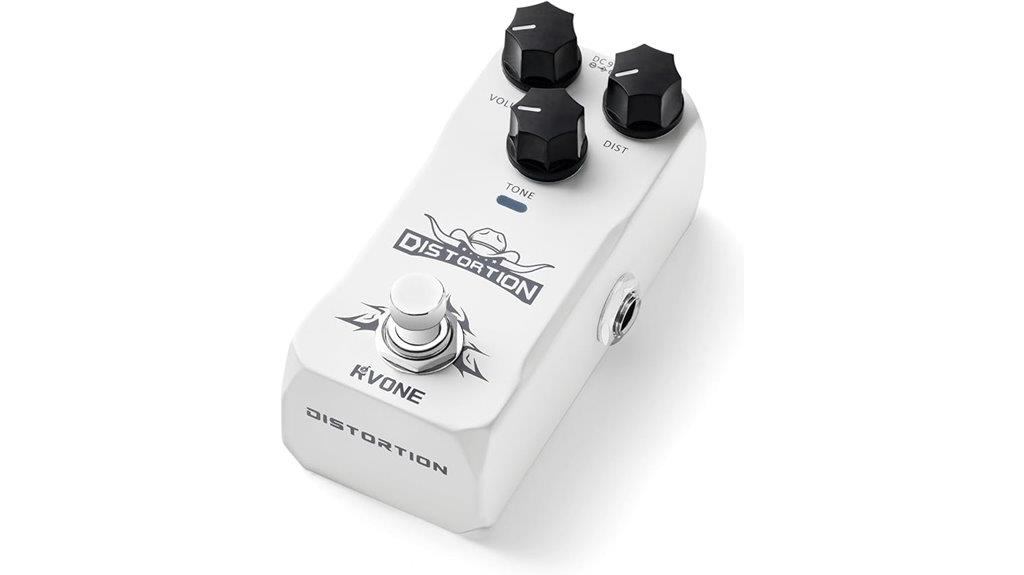
When you’re chasing those thick, saturated tones that cut through a dense mix without losing definition, a high-gain distortion pedal becomes your secret weapon for transforming any amplifier into a powerhouse of analog aggression. These aluminum-constructed units deliver tube-amp soul through analog circuits that recreate vintage amplifier breakup without digital artifacts, offering dynamic versatility from bluesy warmth to face-melting saturation while maintaining note clarity essential for riff-driven genres. The intuitive knob layout provides instant tone sculpting, enabling seamless shifts between crunchy rhythm grit and sustaining lead lines, while tour-tough construction guarantees consistent performance across bedroom practice amps, studio interfaces, and demanding live rigs.
Best For: Electric guitarists seeking professional-grade analog distortion that delivers versatile tones from bluesy warmth to high-gain saturation while maintaining note clarity across practice, studio, and live performance settings.
Pros:
- Analog circuits provide authentic tube-amp breakup tones without digital artifacts, ensuring natural sound quality for studio recordings
- Tour-tough aluminum construction offers lightweight durability that withstands rigorous gigging while remaining portable for pedalboards
- Intuitive knob layout enables instant tone sculpting with seamless transitions between rhythm crunch and sustaining lead tones, even under dim stage lighting
Cons:
- High-gain focus may limit versatility for guitarists primarily seeking subtle overdrive or clean boost effects
- Analog circuitry typically requires more power consumption compared to digital alternatives, potentially draining pedalboard power supplies faster
- Premium aluminum construction and analog components likely command a higher price point than basic plastic distortion pedals
JOYO High Gain Distortion Pedal for Electric Guitar (JF-04)
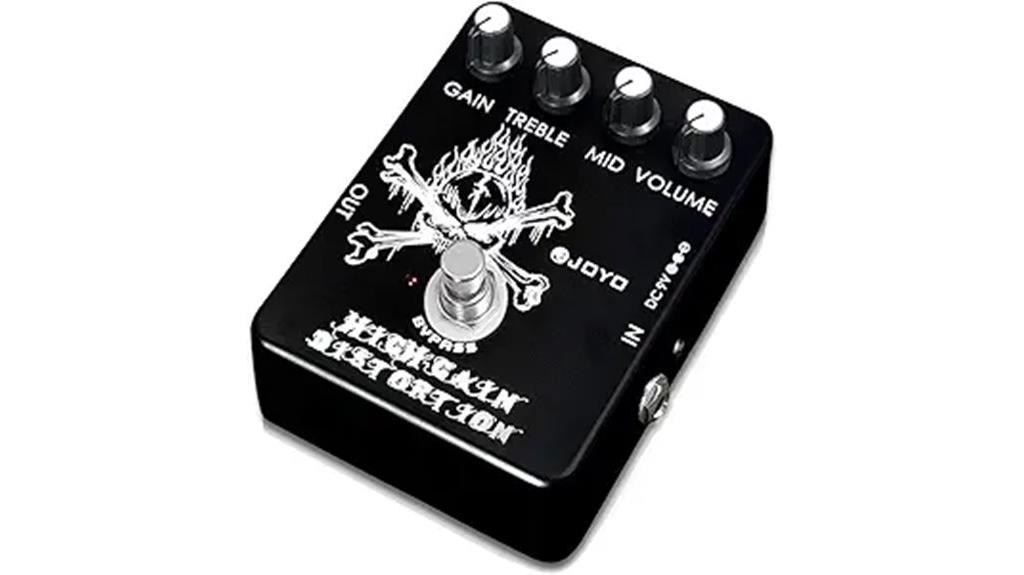
The JOYO High Gain Distortion Pedal (JF-04) stands out as an exceptional choice for budget-conscious guitarists who refuse to compromise on versatility, delivering everything from AC/DC’s signature crunch to Metallica’s crushing heavy metal tones within a single, compact aluminum-alloy housing. You’ll appreciate its full-range EQ adjustments that seamlessly shift from blues rock warmth to face-melting distortion, while the 1/4-inch connectors guarantee compatibility with virtually any electric guitar and amplifier setup. With over 6,000 customer reviews averaging 4.3 stars, this pedal consistently delivers 90% of high-end tube amplifier tone quality at a fraction of the cost.
Best For: Budget-conscious guitarists seeking versatile distortion effects ranging from blues rock to heavy metal without sacrificing sound quality.
Pros:
- Delivers 90% of high-end tube amplifier tone quality at an affordable price point
- Exceptional versatility with full-range EQ adjustments covering AC/DC crunch to Metallica heavy metal tones
- Durable aluminum-alloy construction with excellent customer satisfaction (4.3/5 stars from over 6,000 reviews)
Cons:
- Some units may have defects such as non-functional tuners or background noise issues
- Flanging effects may not meet expectations for users seeking higher-end sound quality
- Requires high-quality power adapters to prevent noise and ensure optimal functionality
FLAMMA FC06 Distortion Guitar Pedal with HP/LP Modes
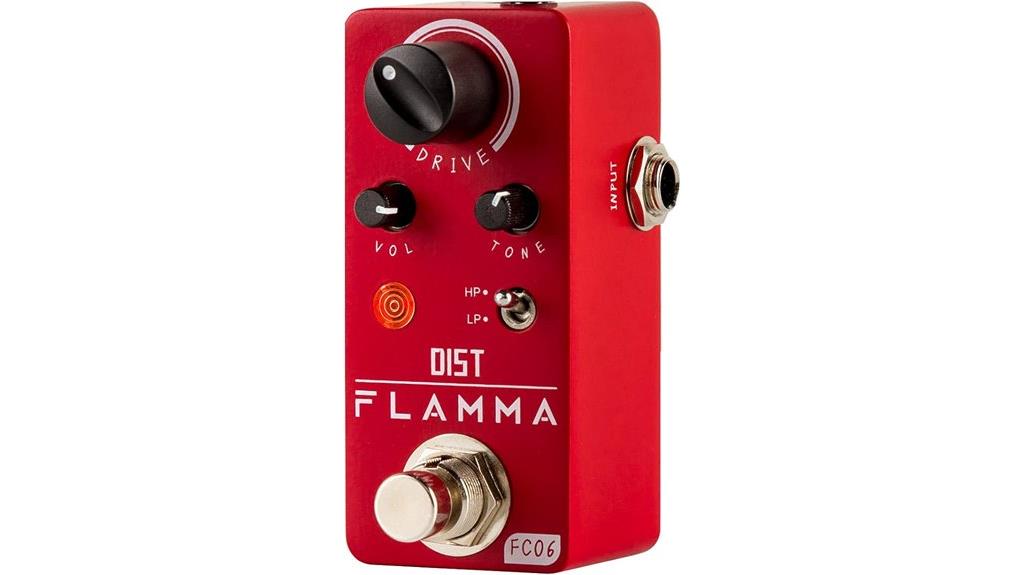
For guitarists seeking versatile distortion that won’t break the bank, FLAMMA’s FC06 delivers dual-personality tone shaping through its innovative HP and LP modes, which I’ve found particularly useful when you need both aggressive midrange punch and subtle clean boosting in a single, compact package. The HP mode enhances low frequencies while boosting that vital 3.5KHz midrange sweet spot, creating vintage tube amp character with impressive dynamic range. Meanwhile, the LP mode provides understated clean boost without heavy coloration, perfect for pushing your amp’s front end. True bypass maintains signal integrity when disengaged, and the 153g metal construction survives regular gigging abuse without complaint.
Best For: Guitarists seeking versatile, budget-friendly distortion with dual-mode functionality for both aggressive midrange punch and subtle clean boosting in live and studio settings.
Pros:
- Dual HP/LP modes provide versatile tonal options from aggressive distortion to clean boost in one compact pedal
- True bypass maintains signal integrity and authentic tone when pedal is disengaged
- Durable full metal construction with mini design offers excellent portability for gigging musicians
Cons:
- Requires separate 9V DC power supply purchase as adapter is not included
- Limited to distortion/boost effects without additional modulation or time-based options
- Single 3.5KHz frequency focus in HP mode may not suit all musical styles or guitar/amp combinations
JOYO Modern Metal High Gain Distortion Guitar Effect Pedal (Dark Flame R-17)

Budget-conscious metal guitarists who crave professional-grade high-gain tones will find exceptional value in the JOYO Modern Metal High Gain Distortion Pedal (Dark Flame R-17), which delivers three distinct distortion modes through an intuitive toggle switch that lets you dial in everything from aggressive rhythm crunch to soaring lead saturation. The thorough 3-band EQ, featuring dedicated LOW, MID, and HIGH controls, provides precise frequency sculpting that’ll help you cut through dense mix arrangements or carve out that perfect palm-muted chug. At just 10.9cm x 6.7cm, this compact powerhouse won’t dominate your pedalboard real estate, while the innovative LED ambience lighting adds visual flair to your setup.
Best For: Budget-conscious metal guitarists seeking professional-grade high-gain distortion with versatile tone-shaping capabilities and compact pedalboard footprint.
Pros:
- Three distinct distortion modes with toggle switch for versatile sound options from rhythm crunch to lead saturation
- Comprehensive 3-band EQ (LOW, MID, HIGH) allows precise frequency sculpting to cut through dense mixes
- Compact dimensions (10.9cm x 6.7cm) save valuable pedalboard space while innovative LED ambience lighting adds visual appeal
Cons:
- Limited to high-gain metal tones, may not suit players seeking cleaner or vintage distortion sounds
- No mention of true bypass switching or buffered bypass specifications
- Single pedal focus on distortion only, lacking additional effects like noise gate or boost commonly needed for metal applications
Donner Distortion Guitar Pedal, Morpher Mini with 3 Modes
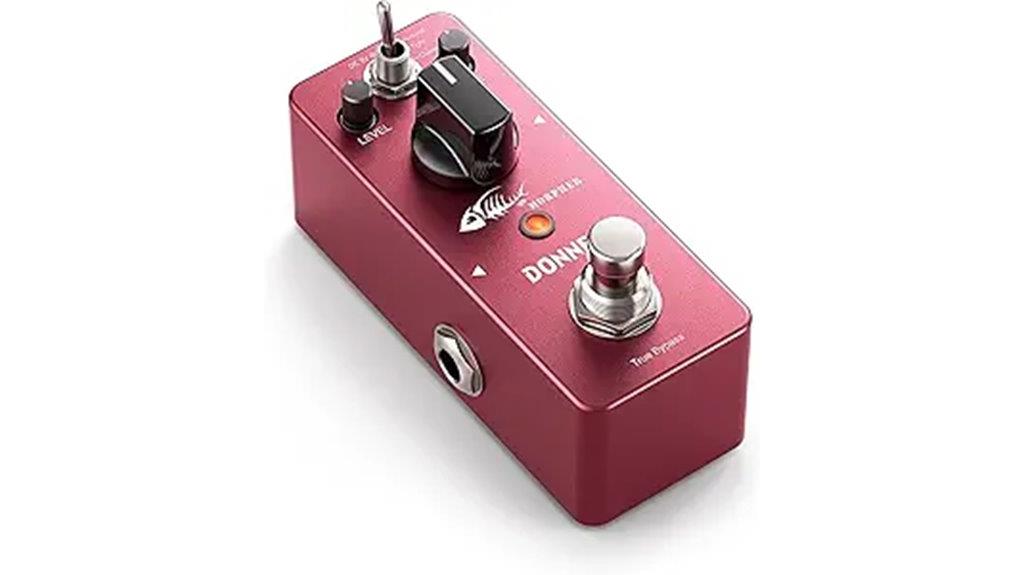
Musicians seeking authentic high-gain distortion without breaking the bank will find the Donner Distortion Guitar Pedal, Morpher Mini with 3 Modes, delivers surprisingly impressive sonic capabilities that rival pedals costing twice as much. You’ll appreciate the three distinct distortion voices—Natural, Tight, and Classic Crunch—which provide remarkable versatility for hair metal, glam rock, and pop metal applications. The aluminum-alloy construction feels reassuringly solid, though you’ll need to budget for a 9V power adapter since there’s no internal battery option. True bypass circuitry maintains your signal integrity, while the compact 6.6-inch footprint won’t crowd your pedalboard like some bulkier alternatives.
Best For: Budget-conscious guitarists who want high-quality distortion for metal genres and need a compact, versatile pedal that delivers professional sound without the premium price tag.
Pros:
- Three distinct distortion modes (Natural, Tight, Classic Crunch) provide excellent versatility for various metal subgenres
- True bypass circuitry maintains signal integrity with no tone loss or frequency degradation
- Durable aluminum-alloy construction in a compact footprint that won’t overcrowd your pedalboard
Cons:
- Requires external 9V power adapter (not included) with no internal battery option
- Limited to rock and metal applications, may not suit players seeking broader genre versatility
- Minimum 500mA current requirement may exceed some power supply capabilities
Boss DS-1 Distortion Bundle with Instrument Cable and Accessories
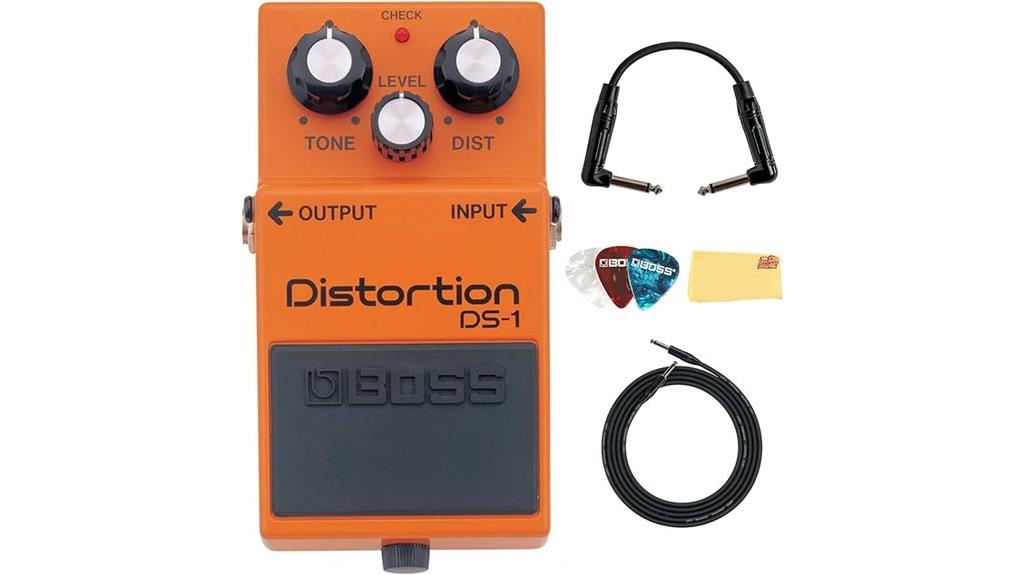
The Boss DS-1 Distortion Bundle stands out as the quintessential choice for guitarists who value proven reliability over flashy innovation, combining the legendary orange pedal with essential accessories that eliminate the frustration of piecing together a complete setup. You’re getting the classic BOSS distortion tones that’ve defined countless recordings, with Distortion, Level, and Tone controls that capture your full playing dynamics from whisper-soft passages to aggressive attacks. The included instrument cable, patch cable, picks, and polishing cloth mean you’ll have everything needed for immediate use, while the 5-year warranty demonstrates BOSS’s confidence in this timeless live performance staple that works equally well with guitars and keyboards.
Best For: Guitarists and keyboardists seeking a reliable, classic distortion pedal with essential accessories included who prioritize proven performance over cutting-edge features.
Pros:
- Complete bundle includes all necessary accessories (cables, picks, polishing cloth) for immediate use
- Versatile controls (Distortion, Level, Tone) that capture full playing dynamics from soft to aggressive
- Backed by BOSS’s 5-year warranty and reputation for durability in live performance settings
Cons:
- May lack modern features or advanced sound-shaping options found in newer distortion pedals
- Classic orange design and sound may not appeal to musicians seeking unique or distinctive tones
- Bundle accessories are basic and may need upgrading for professional or specialized applications
JOYO High Gain Distortion Pedal for Electric Guitar (JF-04)
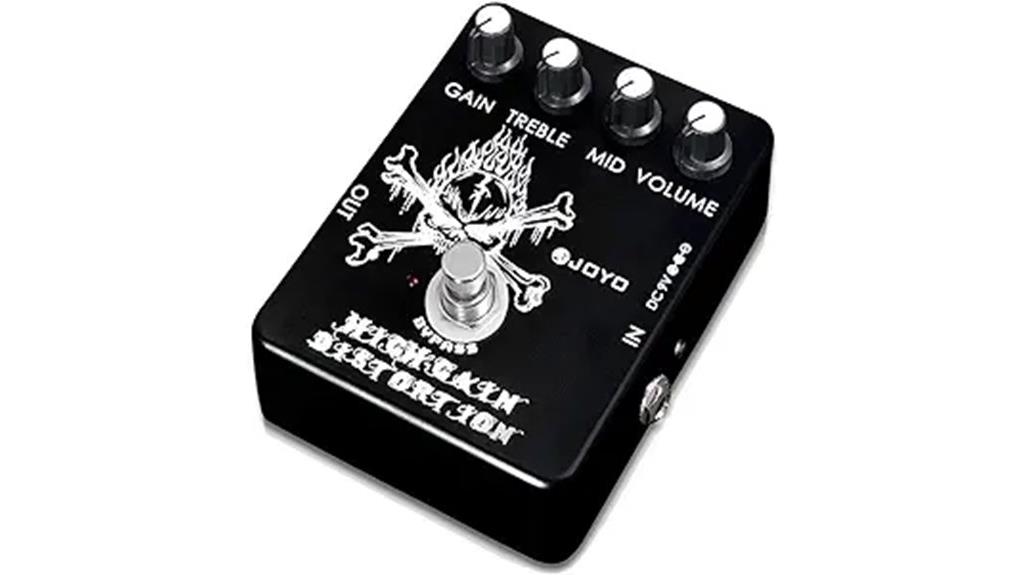
Anyone seeking professional-grade distortion without breaking the bank will find the JOYO High Gain Distortion Pedal (JF-04) delivers remarkable versatility, spanning everything from AC/DC’s signature crunch to Metallica’s brutal heavy metal tones. You’ll appreciate its full-range EQ adjustments, which accommodate single coils and vintage overdrive integration effectively. The aluminum-alloy housing, measuring 4.72 x 2.17 x 3.82 inches and weighing 13.4 ounces, guarantees durability while the LED indicator provides clear operational feedback. Operating on 9 volts DC, it’s compatible with electric guitars through 1/4-inch connectors. With 4.3 out of 5 stars from over 6,000 reviews and achieving 90% of high-end tube amplifier tone quality, this pedal ranks #1 in its category.
Best For: Budget-conscious guitarists seeking professional-grade distortion versatility from blues rock to heavy metal tones without compromising on build quality.
Pros:
- Exceptional versatility spanning AC/DC crunch to Metallica heavy metal with full-range EQ adjustments
- Outstanding value with 90% of high-end tube amplifier tone quality at budget-friendly pricing
- Durable aluminum-alloy construction with clear LED indicator and reliable 9V DC operation
Cons:
- Some units may have defects including non-functional components and background noise issues
- Flanging effects may not meet expectations compared to higher-end premium units
- Sound quality, while excellent for the price, still falls short of true high-end equipment
Distortion Guitar Pedal, Mini Analog with Two-Brand EQ
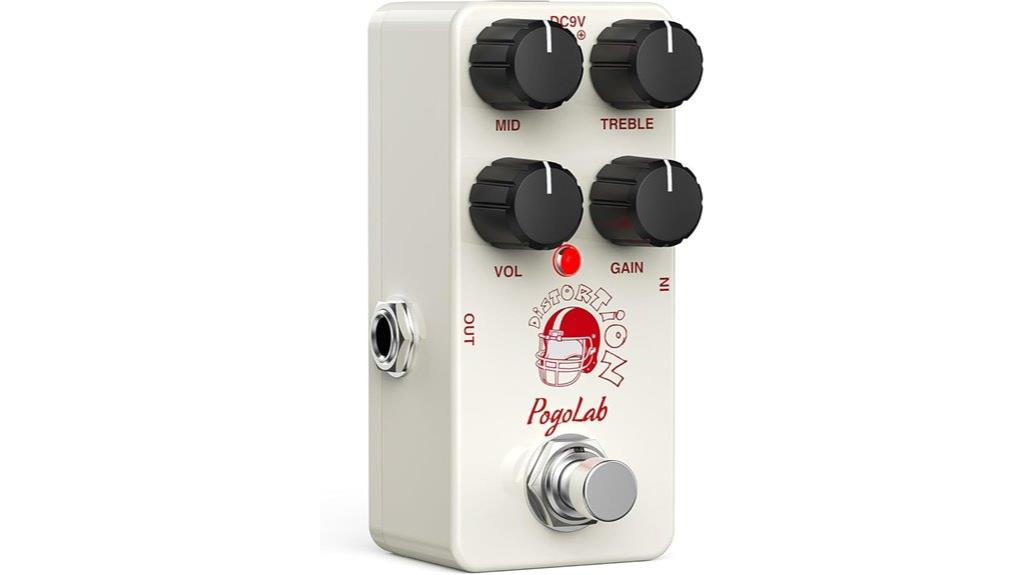
When you’re seeking maximum tonal flexibility in a compact package, the Pogolab Distortion Guitar Pedal delivers impressive versatility through its four-control setup that includes dedicated gain, volume, mid, and treble adjustments. This aluminum alloy-constructed mini pedal weighs just 6.4 ounces, fitting effortlessly on crowded pedalboards while maintaining true bypass switching for signal integrity. You’ll appreciate its wide adjustment range, spanning clean boost to high-gain distortion territories with excellent dynamic response. While some users report minor hiss when engaged, it disappears during actual play, making this an excellent choice for players wanting professional-grade distortion without the bulk.
Best For: Guitar players seeking maximum tonal flexibility in a compact, affordable distortion pedal that offers professional-grade sound quality with versatile controls for both beginners transitioning from complex setups and experienced players needing space-efficient pedalboard solutions.
Pros:
- Four separate controls (gain, volume, mid, treble) provide extensive sound customization from clean boost to high-gain distortion
- Compact aluminum alloy construction weighs only 6.4 ounces while maintaining true bypass switching for optimal signal integrity
- Excellent value with wide adjustment range, dynamic response, and solid build quality at an attractive price point
Cons:
- Requires separate DC 9V power adapter purchase as power supply is not included
- Some users report minor hiss when the pedal is engaged, though it disappears during actual playing
- Limited to two-band EQ (mid and treble) which may not satisfy players wanting more comprehensive frequency control
High Gain Distortion Pedal for Electric Guitar, Analog Effects with True Bypass
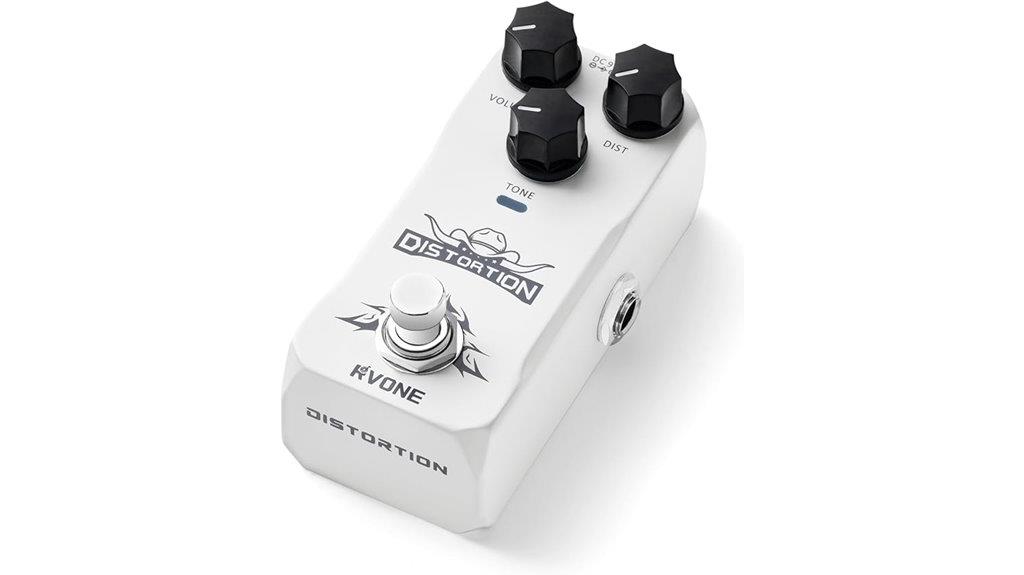
Modern guitarists seeking authentic tube-amp breakup without hauling vintage amplifiers to every venue will find high-gain analog distortion pedals deliver that coveted overdriven sound in a compact, reliable format. These pedals transform clean signals into rich distortion textures through analog circuits that recreate vintage amplifier breakup tones, offering dynamic versatility from bluesy warmth to high-gain saturation while maintaining note clarity essential for riff-driven genres. Tour-tough aluminum construction guarantees durability during rigorous gigs, while true bypass circuitry preserves your original signal when disengaged, eliminating digital artifacts that compromise studio recordings.
Best For: Guitarists who want authentic tube-amp distortion tones in a portable, durable pedal format for stage performances, studio recordings, and practice sessions across multiple amp setups.
Pros:
- Analog circuitry delivers authentic vintage tube-amp breakup tones without digital artifacts
- True bypass preserves original signal integrity when pedal is disengaged
- Tour-tough aluminum construction ensures durability while remaining lightweight and portable
Cons:
- Limited to distortion effects only, lacks additional built-in effects like delay or reverb
- Analog design may produce slight noise floor compared to digital alternatives
- High-gain settings may require careful EQ adjustment to maintain note clarity in dense mixes
Donner Distortion Guitar Pedal, Morpher Mini with 3 Modes
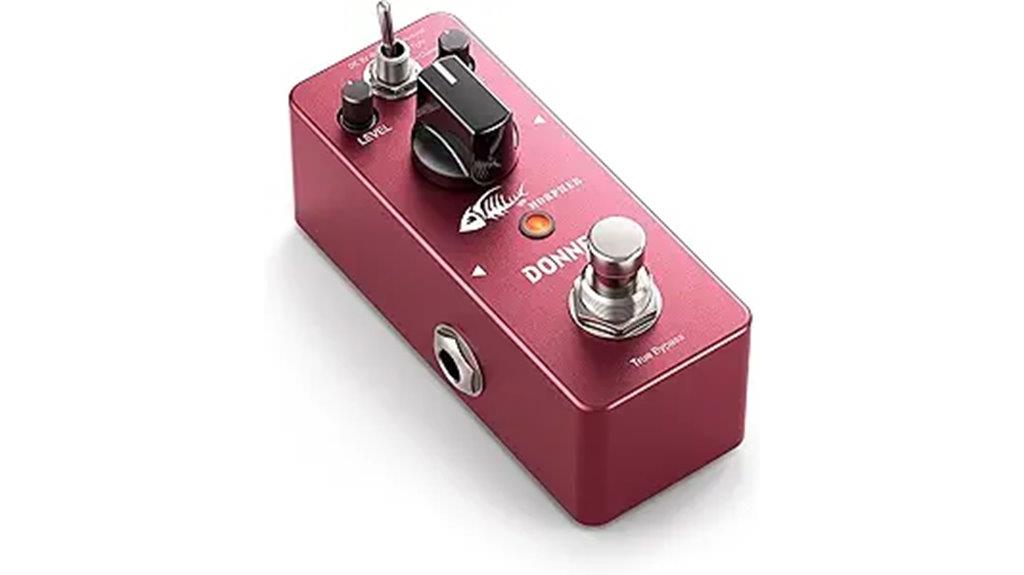
The Donner Distortion Guitar Pedal, Morpher Mini stands out as an exceptional choice for guitarists seeking versatile high-gain tones without breaking the bank, offering three distinct distortion modes that rival pedals costing twice as much. You’ll find Natural, Tight, and Classic Crunch modes that deliver impressive versatility for hair metal, glam metal, and heavy rock applications. The true bypass feature maintains your signal integrity while the durable aluminum-alloy construction, weighing just 8.8 ounces, guarantees this compact pedal will survive countless gigs. With over 21,000 customer reviews averaging 4.3 stars, you’re getting proven performance that works equally well with single coils and humbuckers.
Best For: Budget-conscious guitarists who want versatile high-gain distortion for rock and metal genres, from beginners to experienced players seeking reliable performance without complexity.
Pros:
- Three distinct distortion modes (Natural, Tight, Classic Crunch) provide excellent versatility for various metal and rock styles
- True bypass design maintains signal integrity with no tone loss, plus durable aluminum-alloy construction built for gigging
- Exceptional value with sound quality comparable to much more expensive pedals like MI Crunch Box and Suhr Riot
Cons:
- Requires external 9V DC power adapter (not included) with no internal battery option
- Limited to distortion effects only, lacking additional features like EQ controls or multiple gain stages
- May not satisfy players seeking ultra-modern high-gain tones or more advanced sound shaping capabilities
Factors to Consider When Choosing Distortion Guitar Pedals
When I’m helping guitarists choose their next distortion pedal, I’ve learned that focusing on five critical factors will save you from buyer’s remorse and guarantee you get the tone that matches your musical vision. Sound quality characteristics form the foundation of any pedal decision, but power supply requirements, true bypass features, build quality durability, and tone control options can make or break your overall experience with the unit. I’ll walk you through each consideration systematically, sharing insights from years of testing pedals across different price points, so you can confidently select a distortion pedal that complements your playing style and withstands the rigors of regular use.
Sound Quality Characteristics
Sound quality represents the fundamental cornerstone of any distortion pedal’s performance, and I’ve found that understanding its core characteristics can make the difference between a mediocre tone and one that truly inspires your playing. Analog circuits remain vital for recreating authentic vintage amplifier breakup tones, eliminating those harsh digital artifacts that can make your guitar sound sterile. I’ve noticed that high-quality pedals maintain exceptional note clarity, which becomes essential when you’re playing complex riffs where definition matters. The dynamic versatility allows you to achieve everything from warm bluesy textures to intense high-gain saturation, while detailed tone controls—covering low, mid, and high frequencies—let you customize your sound precisely for different musical genres and playing styles.
Power Supply Requirements
Beyond achieving that perfect tone, I’ve learned that overlooking power supply specifications can quickly turn your dream distortion pedal into a frustrating paperweight or noisy disappointment. Most distortion pedals require 9V DC power, but amperage demands vary dramatically, ranging from 6mA for basic circuits to 500mA or more for complex digital processors. I always check the center negative polarity requirement, as mismatched connections can damage your pedal permanently. While batteries offer portability, I’ve found dedicated power adapters provide superior reliability and consistent performance without the mid-gig battery death anxiety. Using high-quality or original power supplies prevents unwanted noise interference that can muddy your carefully crafted tone, ensuring your pedal operates at peak performance.
True Bypass Features
One critical feature I’ve consistently prioritized in my distortion pedal selection process is true bypass switching, which directly preserves your guitar’s natural signal path when the effect is disengaged. Through years of comparing different pedals, I’ve noticed that true bypass circuits employ mechanical switching mechanisms rather than electronic components, creating an unaltered signal path that maintains your guitar’s original tone and your amplifier’s natural character. This becomes particularly important during live performances, where signal clarity during quiet passages can make or break a song’s dynamics. While I’ll admit I wasn’t always convinced true bypass mattered considerably, high-gain setups especially benefit from this feature since it prevents unwanted noise accumulation and tonal coloring that buffered pedals often introduce into your signal chain.
Build Quality Durability
While true bypass functionality represents a significant performance consideration, the physical construction of your distortion pedal determines whether it’ll survive the inevitable drops, kicks, and general abuse that come with regular gigging. I’ve learned that aluminum alloy housing offers the best balance between durability and weight, creating a lightweight yet sturdy design that won’t weigh down your pedalboard while withstanding transport rigors.
The weight itself tells a story about build quality – heavier pedals typically feature more substantial internal components, though this trades portability for resilience. I appreciate robust construction that includes reliable true bypass switching, which enhances both signal integrity and long-term operational reliability. LED indicators might seem minor, but they’re essential for performance visibility in dimly lit venues, contributing to overall usability.
Tone Control Options
When selecting a distortion pedal, the tone control configuration determines whether you’ll achieve that perfect balance between crushing heaviness and musical clarity that separates amateur noise from professional-grade saturated tones. I’ve found that pedals featuring extensive Bass, Midrange, and Treble adjustments provide the essential foundation for tailoring your signal to match specific musical contexts, whether you’re chasing classic rock crunch or modern metal saturation.
Full-range EQ settings offer the versatility I need to sculpt everything from vintage amplifier breakup to high-gain territory, while built-in mode toggles let me switch between different distortion characteristics instantly. Dynamic response capabilities guarantee note clarity remains intact during complex riff passages, and true bypass switching preserves my signal’s transparency when the effect’s disengaged, maintaining overall sound integrity throughout my performance.
Compatibility With Amps
How effectively your distortion pedal integrates with your amplifier setup can make the difference between achieving that signature saturated tone you’re chasing and ending up with muddy, unfocused noise that fights against your amp’s natural character. I’ve learned that tube amps generally embrace distortion pedals differently than solid-state amps or modelers, with tubes often adding natural compression and harmonic warmth that complements overdrive circuits. Your pedal’s power requirements matter more than you’d think—some circuits demand specific voltage supplies to maintain their intended sonic characteristics. I always check that my distortion maintains consistent personality whether I’m playing through my bedroom practice amp, studio interface, or live rig, ensuring reliable performance across different environments and applications.
Pedal Size Weight
Since I’m constantly rearranging my pedalboard to accommodate new effects, I’ve discovered that pedal size and weight directly influence both my setup’s portability and my performance workflow during gigs. Mini distortion pedals, measuring 4 to 7 inches in length and weighing 6 to 13 ounces, have become my go-to choice for space-constrained boards, especially when I’m hauling gear to multiple venues in a single day. The tour-tough aluminum construction that most manufacturers use strikes an excellent balance between durability and weight reduction, which I appreciate during those late-night load-ins. Compact pedals also provide greater layout flexibility on my board, allowing me to position controls within easy reach during performances without creating an unwieldy, oversized setup.
Price Value Range
Beyond the physical constraints of pedal size and weight, your budget plays an equally important role in determining which distortion pedal will best serve your musical needs and performance goals. I’ve found that distortion pedals typically range from budget-friendly options around $50 to premium models exceeding $200, giving you considerable flexibility in matching your investment to your requirements. While cheaper pedals may lack the robust build quality and sound fidelity of expensive models, many affordable options receive high ratings for functionality, making them ideal for beginners or cost-conscious guitarists. Mid-range pedals usually offer the best balance of quality, versatility, and durability, featuring multiple distortion modes or EQ controls for customization without breaking your budget.
On a final note
I’ve tested countless distortion pedals over the years, and these ten models consistently deliver the tonal versatility you need. Whether you’re chasing vintage overdrive warmth or modern high-gain aggression, there’s something here for every playing style and budget. Don’t overthink it—choose the pedal that matches your musical goals, and you’ll transform your sound immediately. Your amp and fingers do the rest.

